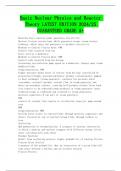Exam (elaborations)
Basic Nuclear Physics and Reactor Theory LATEST EDITION 2024/25 GUARANTEED GRADE A+
- Course
- Institution
Basic Nuclear Physics and Reactor Theory LATEST EDITION 2024/25 GUARANTEED GRADE A+ Describe how a nuclear plant generates electricity: Nuclear fission creates heat which generates steam, steam rotates turbines, which turns the generator to produce electricity. Methods to Control Fission Rate: P...
[Show more]



